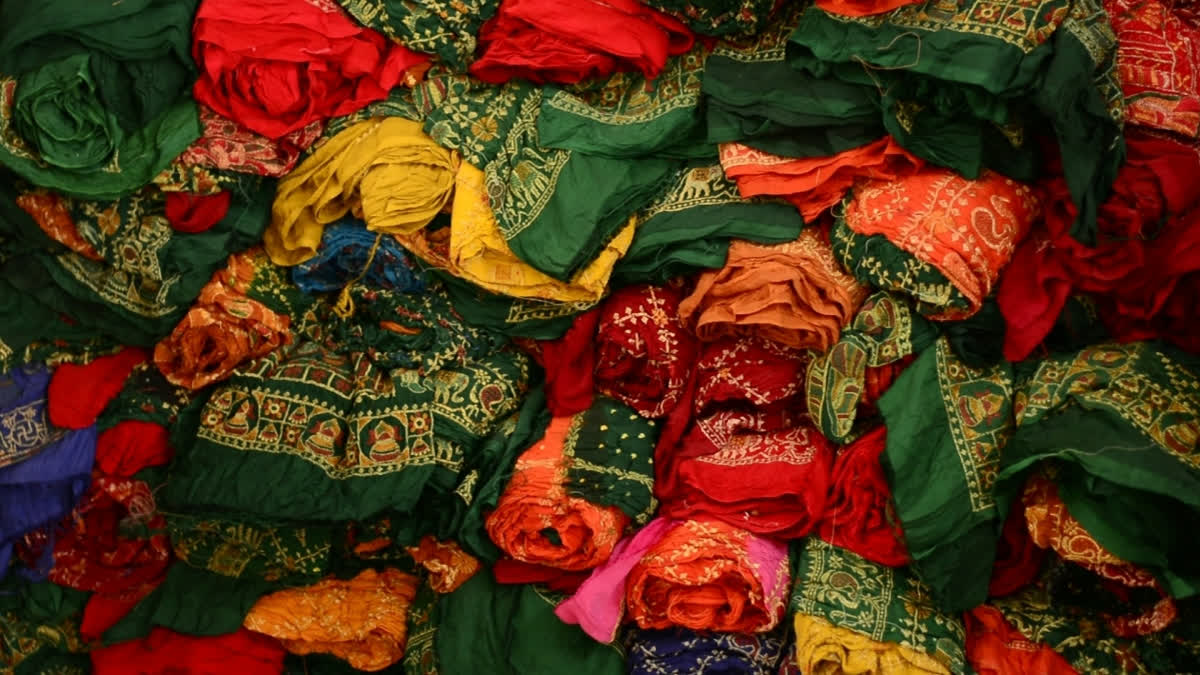Kutch: Kutch needs no introduction today. This city located in the Rann region of Gujarat is famous for its scenic beauty, art and craftsmanship. Artisans here, over the ages have given a distinct identity to Kutchi art, earning them national and international accolades.
One such young artist who has earned immense fame in the Bandhani artform is Abdul Wahab Khatri (25). After nine years of being in the profession, he has recently been awarded the Gold Award for Outstanding Artisan Entrepreneur by the social startup Karigar Clinic. He was earlier awarded the Young Artisan Award in addition to the Kamaladevi Award.
What is Bandhani: Exhibiting a thousand tiny dots, a delicate crinkled texture, and vivid colors, Gujarat's "Bandhani," also known as "tie and dye," is highly regarded and garners a great deal of attention.
This magnificent work of art, which displays the Gujarat Textiles industry's outstanding craftsmanship via elaborate designs, is a legacy of that industry. The Sanskrit term for "tying," "Bandhan," is where the craft gets its name from. It applies to both the method and the finished item. It is made by laboriously pinching, tying, and resist-dying the cloth.
Prevalent for more than 200 years, the Bandhani artisans here have popularised the Kutchi art not only in Gujarat but also in the country and abroad. Khatri took a knack towards this artform since the eighth grade. In 2017, he quit college after studying for a year and got enrolled in a fashion designing course from the Somaiya Kala Vidyalaya in Adipur city.
History: It is believed that Bandhini originated in a prehistoric period for which a precise date cannot be determined. The earliest known textile samples were discovered during the excavation of a tomb at "Astana" in Chinese Turkistan, which dates to the fourth century AD.
The oldest examples of this craft in India can be seen in the sixth and seventh century AD wall paintings found in the Ajanta caves. These paintings show women wearing dotted tie-dye bodices, which are reminiscent of modern Bandhani.
The painting's decoration, dancers' poses, and musical instruments all point to a group of female musicians and dancers from India's Golden Age. The earliest written reference to Bandhini is in Bana’s ‘Harshacharita’ or the ‘Life of King Harsha‘ (606-648 AD), in which the Royal poet Bana narrates the wedding of King’s sister.
In this, he describes with beautiful detail, the tie and dye work done on her special ‘Odhani’ (head cover). King Harsha is known for his taste and works to promote arts and crafts in his reign. The earliest known textile samples were discovered during the excavation of a tomb at "Astana" in Chinese Turkistan, which dates to the fourth century AD.
Nowhere else has Bandhani achieved the same levels of technical proficiency and innovative design as Gujarat. The womenfolk of the village engage in intricate task of tying tiny knots. These women are skilled textile artists who can multitask by skillfully finishing their daily chores and producing exquisite motifs, tying up to 700 knots in a single day.
A typical single stole can have between 4000 and 5000 knots. Knots are relatively easier to tie in silk or cotton materials than in wool. To save down on labor, two or three layers of fabric, depending on thickness, might be tied together. Since the knots in the latter are secured by pulling with the teeth, it calls for a delicate touch.
Annual turnover 1 crore: Khatri makes products priced between Rs 2000 to Rs 80,000. People from famous metro cities of India buy them. Among the best types of Bandhani are Ambadal, Rasmandal, Shikari, Chandrakhani which are highly praised.
Khatri said that he is connected to only two customers abroad but is confident about reaching out to more customers abroad and market his brand internationally. "I want to make the culture of cloth tying and Mufassal popular. Currently, my business has an annual turnover of Rs one crore by selling products both online and offline," he said.
Brother Mohammad Umar said that Abdul handles marketing and sales all by himself. "He posts photos and videos on social media platforms such as Instagram, Facebook and WhatsApp. He also participates in government exhibitions to encourage the sale of Bandhani," Umar said.
Read More:



